Whether you set your sights on creating a masterful cake from scratch with fine embellishments, or baking a simple birthday cake with puffy piped lettering, choosing the right pastry bag may “make or break” your vision. That’s right—this very simple kitchen tool used in most cake decorating classes comes in multiple different materials and sizes.
Pastry bags are not necessarily difficult to use, but it’s critical to know the options available. So whether you’re a professional pastry chef or at-home baker, let’s go over how to choose the right pastry bag to ultimately uplevel your cake decorating techniques.
What Is a Pastry Bag?
Also known as a “piping bag,” a pastry bag is a conical kitchen tool with a small hole at the very end, fit for cake decorating tips.
As mentioned earlier, they are generally easy to use—you squeeze the pastry bag with your hands and apply a degree of pressure to create detailed patterns.
For cake decorating specifically, you may choose from several different tips to achieve your desired look, such as ruffles, flowers, petals, swirls, and more.
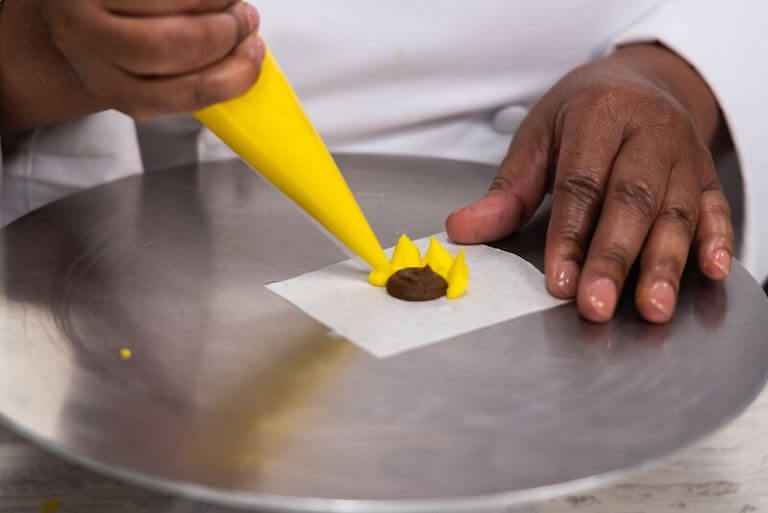
Baker using a plastic pastry bag for an intricate sunflower creation.
How to Choose the Right Pastry Bag for Cake Decorating
Before purchasing a pastry bag, the first “big” step is to choose a cake recipe, scan through the ingredients needed, view the baking instructions, and study any visuals that might guide you along the way.
When it comes to choosing the right pastry bags, you’ll want to understand how much frosting is required, as this will likely impact the size you choose. Also if this is a “one-off” baking project and you don’t plan to bake multiple cakes, you might opt for disposable piping bags versus sturdy, reusable ones that require more extensive cleanup. Let’s dive deeper into the pastry bag options available.
Disposable Pastry Bags
Usually found in most grocery stores, disposable pastry bags are often made out of plastic.
Most disposable pastry bags are more user-friendly since you can visibly see the icing content and they’re easier to trim. Plus you don’t have to wash them vigorously. You can even conveniently craft your own DIY “single-use” pastry bag with a plastic storage bag at home. However, the one major downside is that these pastry bags aren’t too eco-friendly.
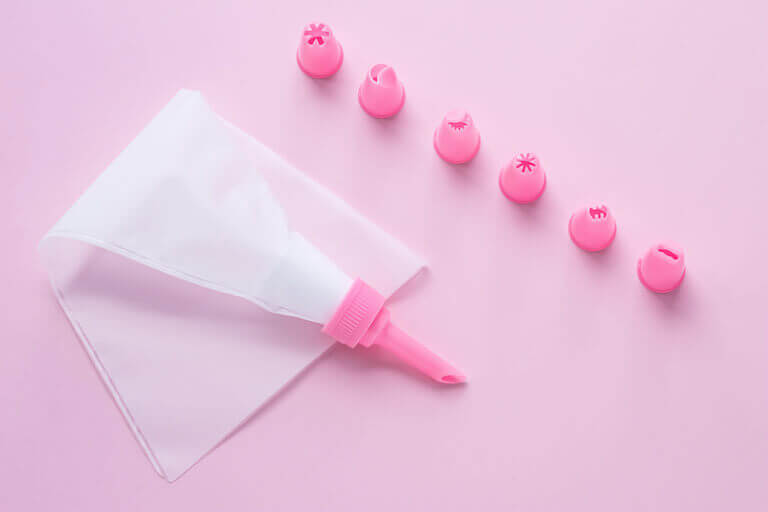
Disposable plastic pastry bags are a great option for a one-time cake project.
Types of Disposable Pastry Bags
- Soft: More flexible, cut to fit any tip, and best for thicker icing decorations
- Striping: Best to pipe multiple colors and easier to fill with a wider body
- High Grip: Best grip option and more fluid dispensing for detailed cake designs
- Plastic Coated: Multi-functional and best for all types of cake piping
Reusable Pastry Bags
As an experienced pastry chef who bakes often, you might opt for reusable pastry bags that may lessen environmental impact. These types are often sturdier and dishwasher friendly—coming in a variety of materials equipped to handle thicker frosting. Many of them also hold space for warmer, denser ingredients and still might prevent leaking too.
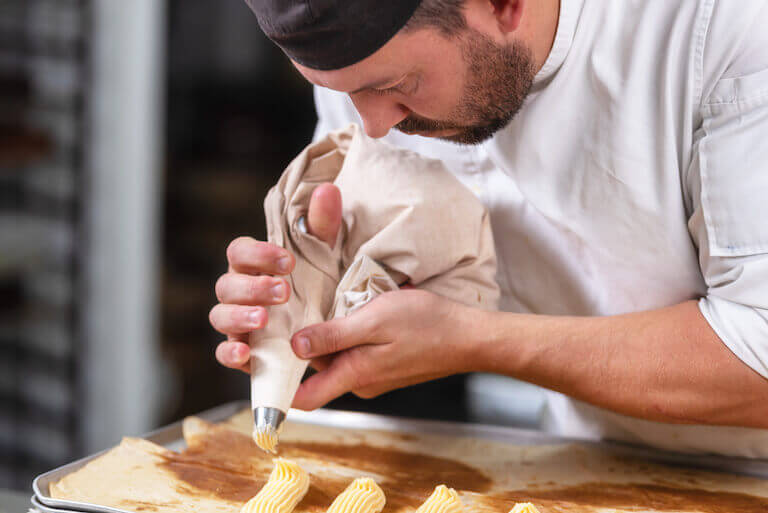
Canvas pastry bags can be reused and are often dishwasher-friendly.
Types of Reusable Pastry Bags
- Canvas: Thicker, more durable material best for thicker frostings
- Polyurethane-Lined Cotton: Heavy-duty commercial-grade and designed for professional pastry chefs
- Nylon: Provides extra longevity and made for denser icing
- Thermoplastic Polyurethane: Very versatile and pliable like silicone
- Polyester: All-purpose pastry bag and very easy to use
Additional Pastry Bag Factors to Consider
Along with choosing the best type of pastry bag for you, there are other components to consider that might impact your overall execution when it comes to cake baking.
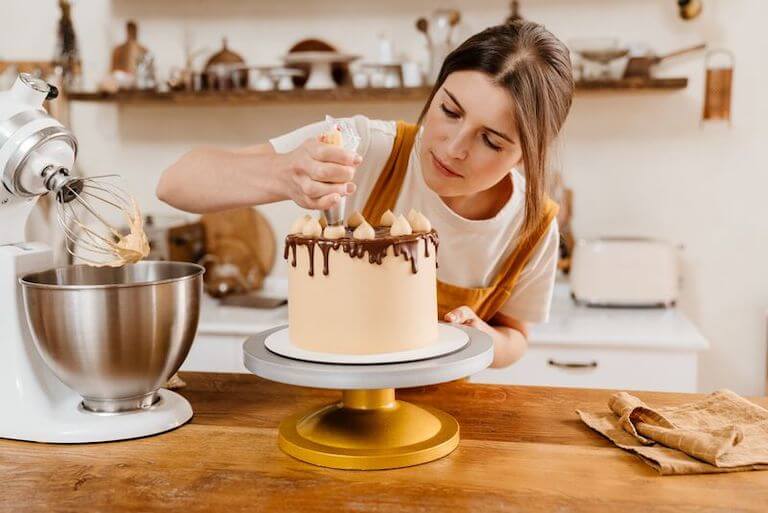
Different pastry bags offer different decorating opportunities.
Size
If you’re engaging in more detailed cake decorating, such as fine lettering, then it might be best to opt for a smaller piping bag with a more minuscule tip—enabling more control. For minimal piping work and certain cake fillings, a medium size bag might be the most optimal. For bigger surface areas and more extensive piping, consider the largest pastry bag options available.
Tip
Some bags are fashioned with a pre-cut, standard tip that might offer you limited decorating options. If you’re looking for a bit more flexibility with cake design options, you might seek a pastry bag where you can cut the tip to fit your exact requirements.
Technique
You might pick the right pastry bag, but the technique is another critical component. How much pressure do you apply to the pastry bag? How can you create more technical icing designs such as a French star?
Students who attend Escoffier’s baking & pastry program can refine these skills even more through custom cake decorating classes that delve into the land of more complex pastries. Along with grasping baking fundamentals, students may discover styles of cake decorating, from basic icings and frosting to decorating techniques and fine-line piping.
“There’s so much about the production of cakes that has been eye-opening. I had some huge epiphanies about [simply creaming the butter and sugar]. I don’t think I ever was properly doing it. And I can see the enormous difference between a professional and home cook, just having someone explain the proper way to do these most basic things.”*
Tara Bissell, Escoffier Online Baking & Pastry Student, Owner/Baker, Andy’s Artisan Bread
Price
Consider how often you’ll use a pastry bag and the investment you’re willing to make. For example, if you’re a professional baker, you might want to bite the bullet and purchase a reusable bag for cake decorating, such as a polyurethane-lined cotton bag that might land in the $20-$30 range.
Take Your Cake Decorating Techniques to the Next Level
There are certain baking tools like the classic pastry bag that may elevate the presentation of your cake. However, if you desire to explore the finer details of cake decorating, it’s worth exploring Escoffier’s cake decorating classes offered in the baking & pastry programs.
Courses in these programs are led by experienced Chef Instructors who can help add to your skillset in the kitchen and guide you on your baking journey! Contact us today to discover more about our programs.
Enjoyed reading this article about baking skills? Try these ones next:
- 6 Advanced Baking Techniques Every Pastry Chef Should Know
- What Can You Learn in Baking School?
- How to Become a Baker
This article was originally published on April 23, 2015, and has since been updated.
*Information may not reflect every student’s experience. Results and outcomes may be based on several factors, such as geographical region or previous experience.

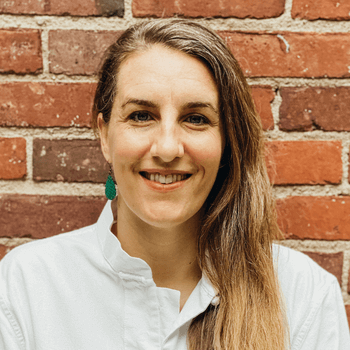 “There’s so much about the production of cakes that has been eye-opening. I had some huge epiphanies about [simply creaming the butter and sugar]. I don’t think I ever was properly doing it. And I can see the enormous difference between a professional and home cook, just having someone explain the proper way to do these most basic things.”*
“There’s so much about the production of cakes that has been eye-opening. I had some huge epiphanies about [simply creaming the butter and sugar]. I don’t think I ever was properly doing it. And I can see the enormous difference between a professional and home cook, just having someone explain the proper way to do these most basic things.”*